Physical Address
304 North Cardinal St.
Dorchester Center, MA 02124
The oesophagus is a fibromuscular tube that carries food through the neck, thorax and abdomen. It extends between the cricoid cartilage of the trachea (at the level of the sixth cervical vertebra) and the gastric cardia (at the level of the 11th thoracic vertebra). In adults, it is approximately 25 cm long. With oesophagogastroduodenoscopy (OGD), it can be measured as starting at 15 cm from the incisors (front teeth) and extending to 40 cm at the gastrooesophageal junction (GOJ). It is divided into upper, middle and lower thirds. The lower third passes through the diaphragmatic hiatus at the level of the 10th thoracic vertebra, and the final 2 to 4 cm lie within the abdominal cavity. The oesophagus is attached to the diaphragm by the phrenooesophageal ligament, a loose extension of the inferior diaphragmatic fascia that allows independent movement of the oesophagus and diaphragm during respiration. The lower thoracic portion of the oesophagus lies in the posterior mediastinum, behind the heart and in front of the aorta. The thoracic duct crosses behind the oesophagus from right to left on its upward path to the drainage point at the junction between the left subclavian and internal jugular veins. The anatomic relationships are shown in Fig. 14.1 .
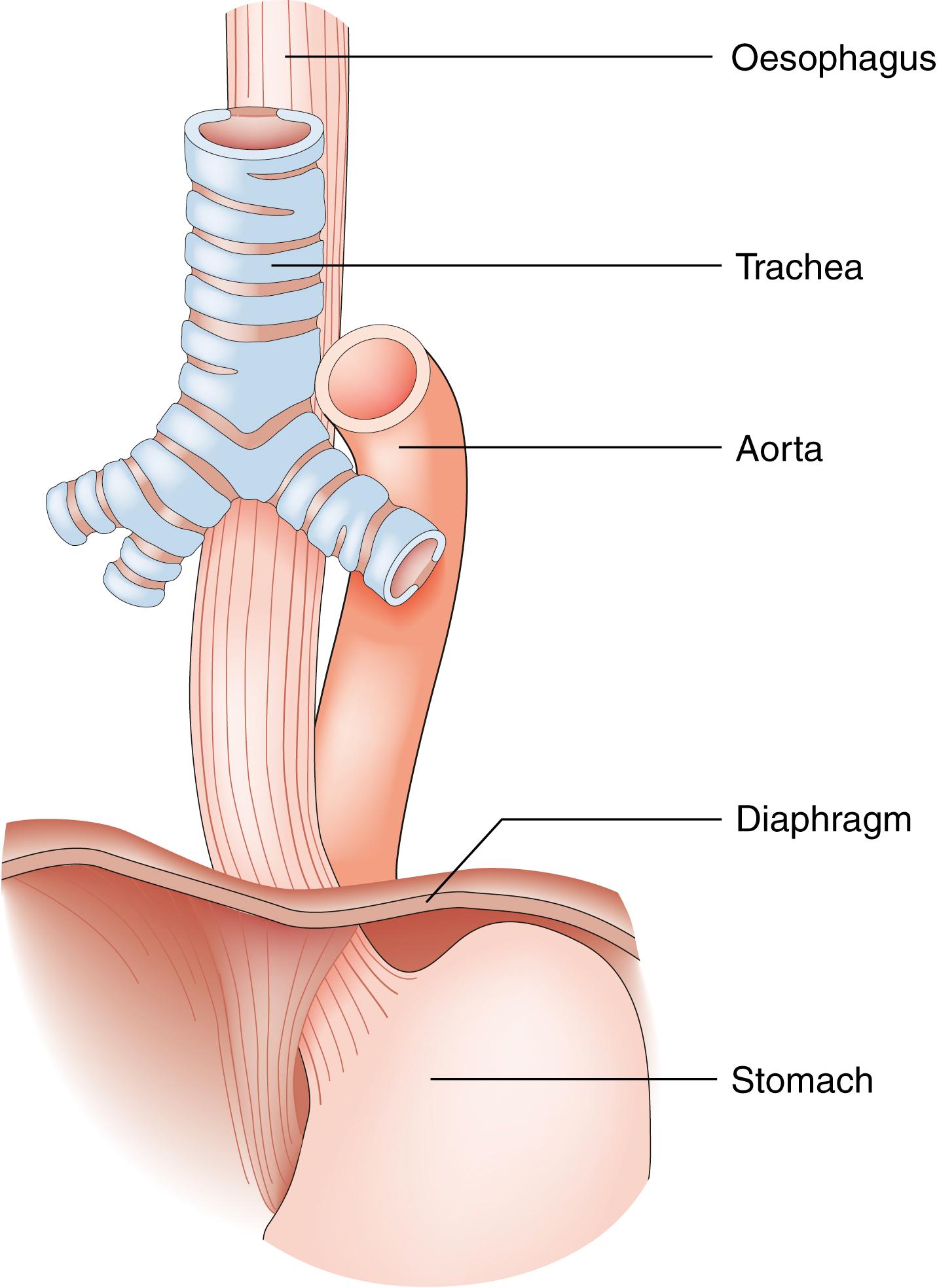
The proximal end of the oesophagus is bounded by a true anatomic sphincter, the cricopharyngeus, whereas the distal end is bounded by a functional lower sphincter with no distinct tissue thickening. This lower oesophageal sphincter (LOS) is approximately 3 to 5 cm long and accounts for approximately 90% of the basal pressure at the GOJ. It involuntarily regulates the prevention of acid reflux and food regurgitation from the stomach.
The oesophagus has four layers: mucosa (including epithelium, lamina propria and muscularis mucosa), submucosa, muscularis externa and adventitia. The epithelium of the oesophagus is stratified squamous. At the GOJ, this squamous epithelium is replaced by stratified columnar epithelium of the stomach at the so-called z-line or squamocolumnar junction. The submucosal layer contains numerous blood vessels, lymphatics and mucous-secreting glands to ease the passage of food. The muscular component of the oesophageal wall is divided into an inner circular layer and an outer longitudinal layer, which are separated by a network of nerve fibres called the myenteric plexus. The upper third musculature consists of skeletal muscle; the middle third contains a mixture of both skeletal and smooth muscle; and the lower third contains only smooth muscle. The oesophagus receives its blood supply from the inferior thyroid artery in the neck; from bronchial arteries and direct branches of the aorta in the thorax; and from the left gastric and inferior phrenic arteries in the abdomen. Venous drainage occurs in both the systemic and portal circulations, an observation of clinical relevance as portal hypertension will lead to development of oesophageal varices. Venous drainage is to the inferior thyroid veins in the neck; to the azygous and hemiazygous veins (systemic circulation draining to superior vena cava) in the thorax; and to the left gastric vein (portal circulation draining to the portal vein) in the abdomen. The oesophagus is innervated by the oesophageal plexus, a combination of branches of the vagal nerves and visceral branches of the sympathetic trunks. Lymphatic drainage is to the deep cervical lymph nodes in the neck/upper third; to the superior and posterior mediastinal nodes in the middle third; and to the coeliac lymph nodes in abdomen/lower third.
The stomach is a muscular, hollow organ that is readily distensible and positioned between the oesophagus and the duodenum in the continuity of the gastrointestinal (GI) tract. It sits in the central/left aspect of the upper abdomen, and its proximal component rests under the costal margin. The anterior surface of the stomach is partly covered by the left lobe of the liver, whereas the stomach bed (the structures that the stomach lies on) include the diaphragm, left adrenal, upper part of the left kidney, splenic artery, pancreas and spleen. The long and short borders of the stomach are known as the greater and lesser curvatures, respectively. The greater omentum, a fat-containing fold of visceral omentum, hangs off the greater curvature like an apron and then doubles back to attach to the transverse colon. The stomach is relatively mobile in the abdomen but is attached to other organs by further double-folds of visceral peritoneum, namely the lesser omentum (between liver, lesser curvature and duodenum) and the gastrosplenic ligament (between greater curvature and spleen). The stomach can be divided anatomically into four distinct regions: namely, the cardia, fundus, body and antrum. Distally, the stomach is limited by the pylorus, a true anatomic sphincter. It is composed of greatly thickened inner circular muscle that helps regulate stomach contents emptying into the duodenum.
The stomach has an extensive arterial blood supply ( Fig. 14.2 ) derived from divisions of the coeliac axis. Because of the free communication between the vessels supplying the stomach, ischaemia does not usually result. The veins from the stomach and duodenum accompany the arteries and drain into the portal venous system, whereas the lymphatics from the stomach accompany the arteries and drain into nodes around these vessels. Thereafter, drainage is to other groups around the liver, splenic hilum, pancreas, coeliac axis, superior mesenteric artery and aorta.

The parasympathetic nerve supply to the stomach is derived from the anterior (left) and posterior (right) vagal trunks, which pass through the diaphragm with the oesophagus. The anterior trunk gives off branches to the liver and gallbladder, descending along the lesser curvature as the anterior nerve of Latarjet. The posterior trunk gives off a coeliac branch and descends along the lesser curvature of the stomach as the posterior nerve of Latarjet, going on to supply the pancreas, small intestine and large intestine as far as the distal transverse colon. The parasympathetic system supplies motor fibres to the stomach wall, inhibitory fibres to the pyloric sphincter (thus effecting relaxation of the sphincter) and secretomotor fibres to the glands of the stomach. Sympathetic fibres arise from T6-T9 spinal segments and accompany the gastric arteries to reach the stomach from the coeliac ganglion. These provide excitatory motor fibres to the pyloric sphincter and some pain fibres.
The duodenum is divided into four parts, which are closely applied to the head of the pancreas. The first part is approximately 5 cm in length; it is important because it is the most common site for peptic ulceration. The second part has the ampulla of Vater on its medial wall, where the conjoined pancreatic duct and common bile duct deliver their contents to the GI tract. The third and fourth parts pass behind the transverse mesocolon into the infracolic compartment. The blood supply to the duodenum is derived from both the coeliac axis (via the gastroduodenal artery) and branches from the superior mesenteric artery (inferior pancreaticoduodenal artery). The lymphatics of the duodenum drain into the nodes located at the coeliac axis and superior mesenteric vessels. The duodenum receives sympathetic and parasympathetic supply from the coeliac and superior mesenteric plexuses.
Oesophageal peristalsis results from sequential contraction and relaxation of oesophageal muscle, which serves to propel an ingested food bolus towards the stomach. Around 1 L of alkaline saliva is produced each day by the salivary glands, which helps lubricate the bolus and neutralises refluxed gastric acid. Peristalsis is initiated by swallowing (primary) or luminal distension (secondary), and progresses distally at around 2.5 to 5 cm/s. The lower sphincter momentarily relaxes for 2 to 3 seconds before the peristaltic wave arrives, and peak pressures of about 70 mm Hg are usually generated in the lower oesophagus. Disruption of any part of this process can result in difficulties with swallowing and/or pain.
Between the outer longitudinal muscle layer and the inner circular layer is a nerve plexus (Auerbach or myenteric plexus) that receives parasympathetic motor innervation to smooth muscle cells from vagal nuclei in the dorsal nucleus of the medulla oblongata. Between the inner muscular layer and the submucosa is another nerve plexus (Meissner or submucosal plexus) that consists of fibres and cells derived from the myenteric plexus perforating the circular muscle layer. The submucosal plexus innervates the mucosa and muscularis mucosae, relaying signals from the numerous free nerve endings in the mucosa and submucosa to vagal afferent fibres. This sensory information is sent back to the brain via the vagal nerve trunks. Sympathetic innervation arrives via preganglionic sympathetic fibres from the spinal cord that synapse with postganglionic nerve cells in sympathetic ganglia before passing to the oesophagus with the blood vessels. Together, the myenteric and submucosal plexuses constitute part of the enteric nervous system (ENS) of the gut that can be influenced by both neural and hormonal stimuli. If the vagus nerves are severed, the ENS can work independently from the central nervous system (CNS).
Food is passed from the oesophagus into the stomach, where it is stored, ground and partially digested. As food enters the stomach, the muscles in the stomach walls relax so that intragastric pressure rises only slightly. This effect is known as receptive relaxation and is mediated by the vagus nerve. It is followed by muscular contractions that increase in amplitude and frequency, starting in the fundus and moving down towards the body and antrum. In the antrum, the main role is the grinding of food and propulsion of small amounts (now called chyme) into the duodenum when the pyloric sphincter relaxes.
Gastric emptying is controlled by two mechanisms: hormonal feedback and a neural reflex called the enterogastric reflex. In the former, fat in the chyme is the main stimulus to produce a number of hormones, the most powerful being cholecystokinin, which exerts a negative feedback effect on the stomach, decreasing its motility. Other inhibitory hormones include secretin, peptide YY and vasoactive intestinal peptide (VIP). The enterogastric reflex is initiated by stretching of the duodenal wall, which further slows stomach emptying and secretion.
Gastric secretion is divided into three phases: cephalic (neural), gastric and intestinal. The cephalic phase is induced by the sight, smell and taste of food, and approximately 20% of total acid secretion occurs before food reaches the stomach. Most gastric secretion takes place during the gastric phase, the result of stomach stretching (called the vagovagal reflex) and the stimulation of chemoreceptors by food. During the intestinal phase, partially digested amino acids in duodenal chyme cause duodenal G-cells to release gastrin, resulting in gastric acid production.
Acid production occurs in the parietal cells of the stomach. Acid secretion by these cells is stimulated by two factors: acetylcholine released by the vagus nerve and gastrin from the antrum and duodenum. Acetylcholine and gastrin act on neuroendocrine cells located close to the parietal cells. When stimulated, these cells release histamine, which has a paracrine action on the parietal cell, stimulating acid production and secretion. Parietal cells secrete acid via an active transport mechanism, the proton pump. Somatostatin, gastric inhibitory peptide and VIP inhibit acid secretion.
Pepsin is a proteolytic enzyme produced in its precursor form, pepsinogen, by the gastric chief cells found in the body and fundus of the stomach. Pepsinogen production is stimulated by acetylcholine from the vagus nerve. The precursor is then converted to its active form, pepsin, by the acid contents of the stomach.
Mucus is produced by all regions of the stomach. It is composed mainly of glycoproteins, water and electrolytes, acting as a lubricant protecting the surface of the stomach against the powerful digestive properties of acid and pepsin. Bicarbonate ions are secreted into the mucus gel layer, which creates a protective buffer zone against the effects of low-pH secretions. Alkaline mucus is produced in the duodenum and small intestine, where it has a similar function of mucosal protection.
Intrinsic factor is also produced by the parietal cells. It is a glycoprotein that binds to vitamin B 12 present in the diet, which carries it to the terminal ileum. Here, specific receptors for intrinsic factor exist, and the complex is taken up by the mucosa. Intrinsic factor is broken down, and vitamin B 12 is then absorbed into the bloodstream.
Symptoms and signs of the upper GI tract can be classified as those that probably represent benign clinical complaints and those that are known as ‘alarm’ or ‘red flag’ symptoms indicative of a possible malignant aetiology ( EBM 14.1 ).
‘Offer urgent direct access upper gastrointestinal endoscopy (to be performed within 2 weeks) to assess for oesophageal cancer in people with dysphagia or aged 55 and over with weight loss and any of the following - upper abdominal pain, reflux, dyspepsia.’
Patients with alarm symptoms require an urgent OGD to exclude a tumour of the upper GI tract. However, doctors should exercise caution with the interpretation of symptoms, keeping a high index of suspicion of underlying malignancy, especially in elderly patients and those with treatment-refractory symptoms. Upper GI cancers can cause a wide range of (sometimes vague) symptoms, and, by definition, each would therefore also be an alarm symptom. Common alarm symptoms are listed next.
Dysphagia is defined as difficulty when swallowing. It is a serious symptom that requires investigation regardless of clinical diagnosis. A list of common causes of dysphagia is shown in Table 14.1 . The following characteristics should be considered:
Site. Patients often find it difficult to describe the exact area of obstructive symptoms, and when they can, the sensation does not always correlate well with the actual site of obstruction. However, a sensation of upper (oropharyngeal) dysphagia may represent a functional motility problem or possibly a pharyngeal pouch. In this situation, if OGD is normal, patients should be considered for an assessment by an ear, nose and throat (ENT) specialist.
Onset. In patients with oesophageal cancer, dysphagia tends to occur rapidly (over weeks/months), whereas patients with benign problems (e.g., stricture, achalasia) tend to develop symptoms over a longer period (years). Sudden onset of dysphagia suggests obstruction by foreign body (usually a food bolus in adults).
Progression. Patients with cancer or benign strictures will describe progressive dysphagia that causes initial difficulties with solid foods, and then soft foods, and ultimately, liquids. Patients with benign motility disorders may experience intermittent symptoms that affect solids and liquids similarly or may even be worse with liquids.
| Intraluminal | Intramural | Extrinsic |
|---|---|---|
| Pharynx/upper oesophagus | ||
| Foreign body | Pharyngitis/tonsillitis Moniliasis Sideropenic web Corrosives Carcinoma Myasthenia gravis Bulbar palsy |
Thyroid enlargement Pharyngeal pouch |
| Body of oesophagus | ||
| Foreign body | Corrosives Peptic oesophagitis Carcinoma |
Mediastinal lymph nodes Aortic aneurysm |
| Lower oesophagus | ||
| Foreign body | Corrosives Peptic oesophagitis Carcinoma Diffuse oesophageal spasm Systemic sclerosis Achalasia Postvagotomy |
Paraoesophageal hernia |
Odynophagia is defined as pain on swallowing. It may be experienced by patients with oesophagitis or oesophageal spasm. In patients with oesophageal cancer, odynophagia and chest pain are concerning symptoms suggestive of locally advanced disease.
Dyspepsia is something of a ‘catch-all’ term used to describe symptoms of indigestion that are very common in the general population. Patients may experience epigastric pain, belching, heartburn, nausea, bloating, early satiety or reduced appetite. Guidance from the National Institute for Clinical Excellence (NICE) in the UK recommends lifestyle advice, medication review and empirical treatment for most patients with dyspepsia but without alarm symptoms ( EBM 14.2 ).
‘ Consider referral to a specialist service for people of any age with gastrooesophageal symptoms that are non-responsive to treatment or unexplained; with suspected GORD who are thinking about surgery; with H pylori that has not responded to second-line eradication therapy. ’
Unfortunately, the symptoms of early upper GI malignancy can be similar to dyspepsia, and only advanced malignancies tend to cause alarm symptoms. Patients with advanced upper GI malignancy have a poor prognosis despite aggressive therapy, which creates a dilemma: which patients with dyspepsia should be referred for endoscopy? NICE guidance recommends upper GI endoscopy on patients aged >55 years with treatment-resistant dyspepsia. However, such guidance should be applied with caution, and doctors should recommend gastroscopy in patients of any age who do not quickly improve with simple treatment. It is also imperative that a careful history is taken and that other concerning features, such as weight loss, anaemia and raised platelet count, are excluded.
Epigastric pain is a common symptom with a wide differential diagnosis. Pain relieved by eating traditionally suggests a duodenal ulcer, whereas gastric ulcer pain is aggravated by food. Alternative causes include gallstones, pancreatitis, liver metastasis, abdominal aortic aneurysm, irritable bowel and even myocardial infarction.
Retrosternal pain is a very common symptom, and most people will have experienced it at some time. It is usually associated with gastrooesophageal reflux and may be brought on by eating a heavy meal, alcohol or bending over. General practitioners will see many patients in their clinical practice who complain of heartburn that can be effectively treated with acid-suppressing medications, such as proton pump inhibitors (PPIs). However, once again, treatment-resistant heartburn, particularly in those patients aged >55 years or those who have other concerning symptoms, should be referred for urgent endoscopy to exclude oesophageal cancer.
Vomiting is an active process whereby the stomach contents are forcefully expelled by powerful contractions of the abdominal musculature at the same time as relaxation of the LOS. Potential causes of vomiting include infection, inflammation, endocrine disorders, drugs and medication, GI obstruction and physiologic issues, such as morning sickness in pregnancy. Persistent vomiting in conjunction with weight loss, other upper GI symptoms or blood abnormalities should be considered an alarm symptom.
Regurgitation is an effortless (passive) process whereby food is regurgitated into the mouth. It is associated with conditions that cause dysphagia, including malignancy and achalasia. Other causes include hiatus hernia, pharyngeal pouches and rumination syndrome (effortless regurgitation due to involuntary contraction of the abdominal muscles). Regurgitation can lead to aspiration with coughing/choking, asthma and aspiration pneumonia.
Unexplained, involuntary weight loss is a worrying problem that can be caused by malignancy, obstructive pathologies, endocrine disorders and inflammatory conditions. In patients with cancer, weight loss can occur through metabolic changes and/or a reduction in appetite and food intake. If a patient is diagnosed with cancer, further weight loss can occur through the effects of treatment (e.g., chemotherapy or surgery). These multiple causes of weight loss in connection with cancer combine to form a syndrome known as cancer cachexia. If a patient presents with symptoms of unexplained weight loss and investigations of the upper GI tract are normal, then further investigations (e.g., CT chest, abdomen and pelvis) should be performed to exclude an alternative cause or site of malignancy. Patients will also benefit by referral to a dietician.
The finding of an upper abdominal mass is very concerning for the presence of locally advanced GI cancer and is a strong indication for CT scan and/or further investigations such as OGD. Despite the obvious clinical finding, the patient may be unaware of the mass.
Upper GI bleeding may be acute and severe, and patients may present as an emergency with haematemesis and/or melaena. Clinical scoring systems are available to aid decision-making. The Glasgow-Blatchford score is a screening tool that uses blood and clinical parameters to assess the need for OGD (to diagnose and/or control bleeding) or blood transfusion, whereas the Rockall score uses patient characteristics and clinical parameters to predict the risk of adverse outcomes in patients with upper GI bleeding. However, patients may also present nonemergently with more indolent episodes of haematemesis or unexplained iron-deficiency anaemia, both of which should be considered alarm symptoms. Iron-deficiency anaemia is a sign of slow ‘occult’ bleeding, and patients should be referred for consideration of both upper and lower endoscopies.
Examination of the hands and nails may reveal koilonychia (spoon-shaped nails), a sign of iron-deficiency anaemia, which may be present in upper GI malignancy and Plummer-Vinson syndrome (oesophageal web associated with anaemia; otherwise known as Paterson-Brown-Kelly syndrome). Others signs of iron-deficiency anaemia in the face may include angular stomatitis, glossitis and subconjunctival pallor. Jaundice may be seen in the eyes, suggestive of possible liver metastasis. Examination of the neck may reveal lymphadenopathy from metastatic spread, particularly in the left supraclavicular region (known as Virchow node or Troisier sign), which represents the drainage region of the thoracic duct. Abdominal signs of advanced malignancy may include an upper abdominal mass, hepatomegaly, ascites, a metastatic deposit in the umbilicus (known as Sister Mary Joseph nodule) and a palpable mass in the pouch of Douglas on rectal examination (known as Blumer shelf). Dark, velvety discolouration of the skin of the axillae and groin is known as acanthosis nigricans, and is another sign of malignancy, especially stomach cancer. A succussion splash heard over the epigastrium when the patient is gently shaken suggests gastric outlet obstruction.
A full blood count (FBC) may reveal infection or anaemia, which will be microcytic when iron-deficient. FBC results may be combined with iron studies and vitamin B 12 /folate studies to establish the exact type of anaemia. Serum biochemistry may reveal elevated urea in upper GI bleeding and both elevated urea and creatinine in dehydration (due to vomiting or dysphagia) or acute kidney injury. Electrolyte disturbance, including hypokalaemic and hypochloraemic acidosis, may be present in prolonged vomiting due to gastric outlet obstruction. Acid-base disturbance can be confirmed and quantified using arterial blood gas analysis. Liver function tests may demonstrate elevated bilirubin and transaminases in malignant liver infiltration, along with abnormalities of blood clotting. Patients with both cancer and infection may demonstrate features of a systemic inflammatory response with raised C-reactive protein (CRP)/erythrocyte sedimentation rate (ESR), changes in white cell count differential and a reduced albumin level.
It is recommended that patients with dyspepsia be tested for infection with Helicobacter pylori, a spiral bacterium that is the commonest worldwide cause of peptic ulceration and gastric adenocarcinoma ( EBM 14.3 ).
‘ RCTs have found that Helicobacter eradication is superior to acid-lowering drugs in duodenal ulcer healing, and both are superior to no treatment. In preventing duodenal ulcer recurrence, eradication therapy was similar to maintenance acid-lowering drugs, but eradication therapy was superior to no treatment. In gastric ulcer healing, eradication therapy was similar to acid-lowering drugs. In preventing gastric ulcer recurrence, eradication therapy was superior to no treatment. ’
Many tests are based on the ability of H. pylori to convert urea to ammonia and carbon dioxide, which require the patient to have ceased antacid medication for the preceding 2 weeks. H. pylori can be detected in the following ways:
Stool antigen test – detects H. pylori antigens in faeces
Blood test – detects antibodies to H. pylori
Urea breath test – detects carbon dioxide excretion following the oral ingestion of radiolabelled urea
Rapid urease test or CLO (Campylobacter-like organism) test – performed on endoscopic tissue biopsies
Histology – detects visible H. pylori organisms in endoscopic tissue biopsies
Chest x-ray (CXR): A CXR may show a retrocardiac air-fluid level with associated mass in large hiatus hernia ( Fig. 14.3 ); pulmonary consolidation following aspiration in any patient with dysphagia; pulmonary metastases, mediastinal lymphadenopathy and pleural effusion in advanced cancer; and pneumothorax, pleural effusion and air in the neck/mediastinum (pneumomediastinum) in oesophageal perforation ( Fig. 14.4 ). To diagnose air in the peritoneal cavity (pneumoperitoneum) due to a ruptured hollow visus (e.g., perforated duodenal ulcer), an erect (rather than supine) CXR is required ( Fig. 14.5 ). However, in this scenario, erect CXR may only be positive for pneumomediastinum in approximately 60% cases of perforation.
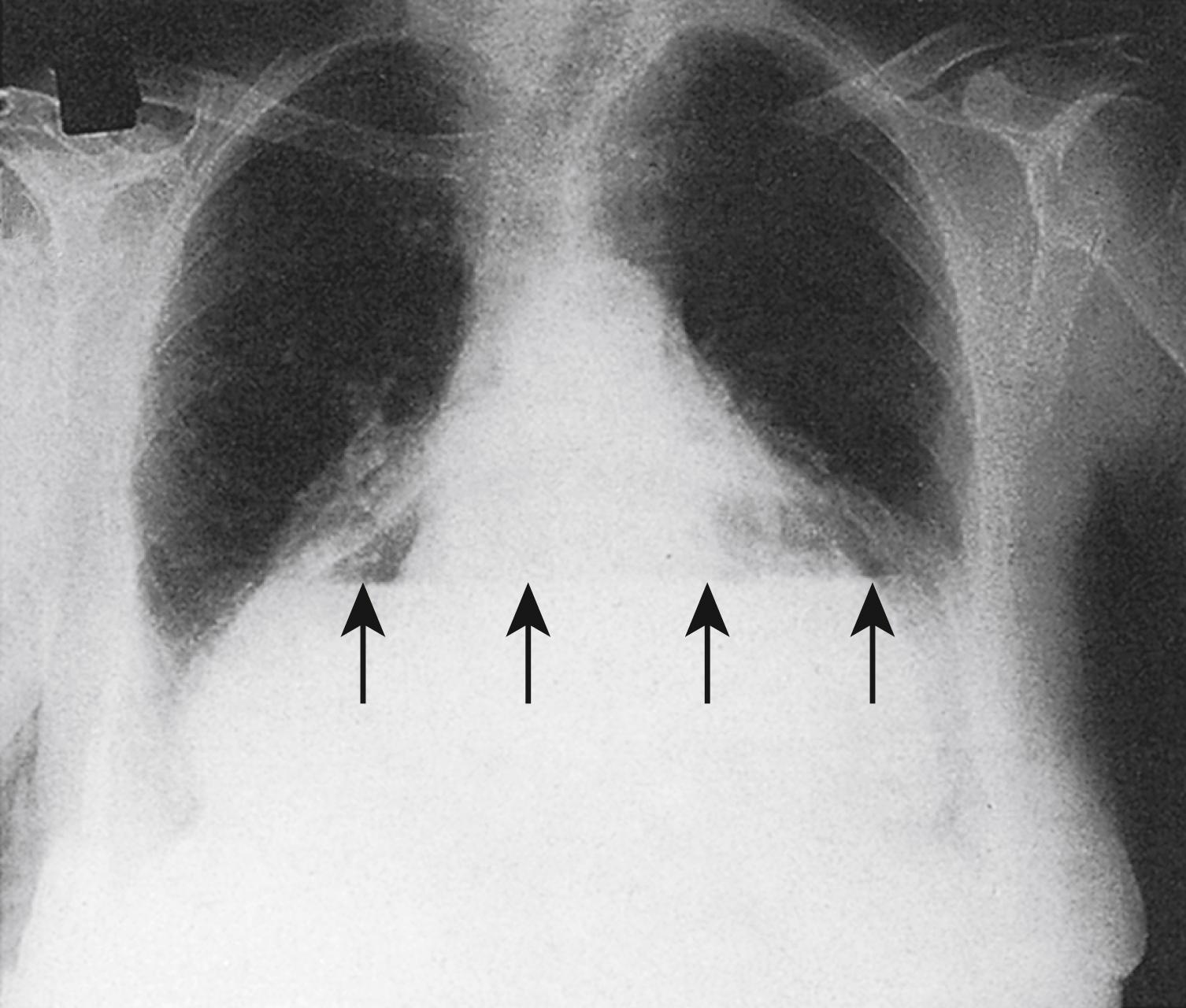
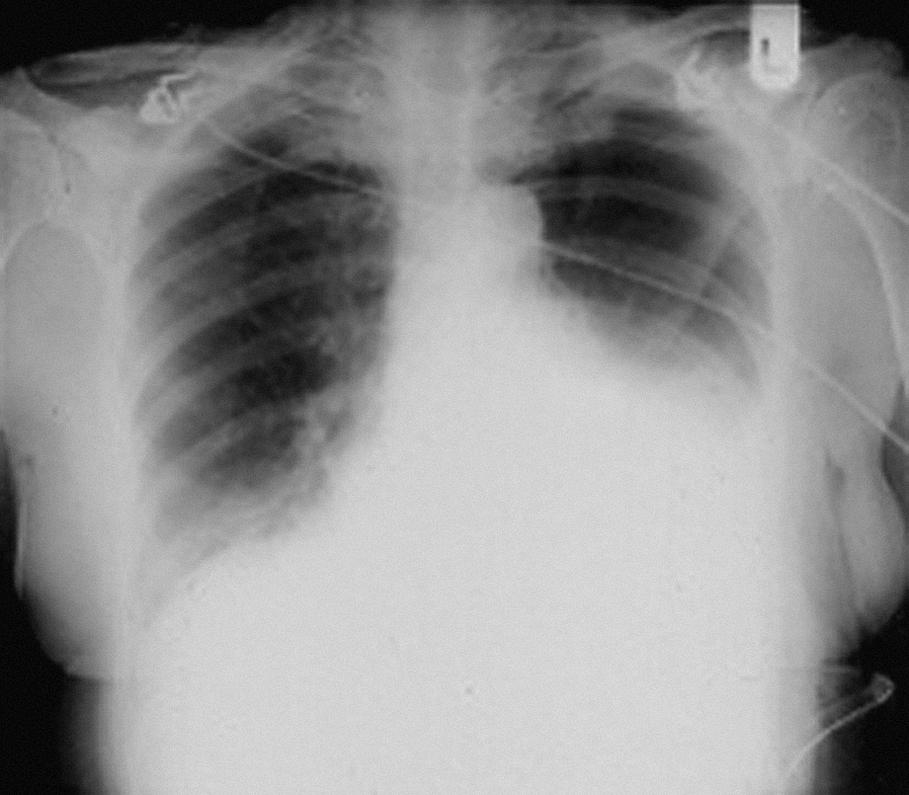
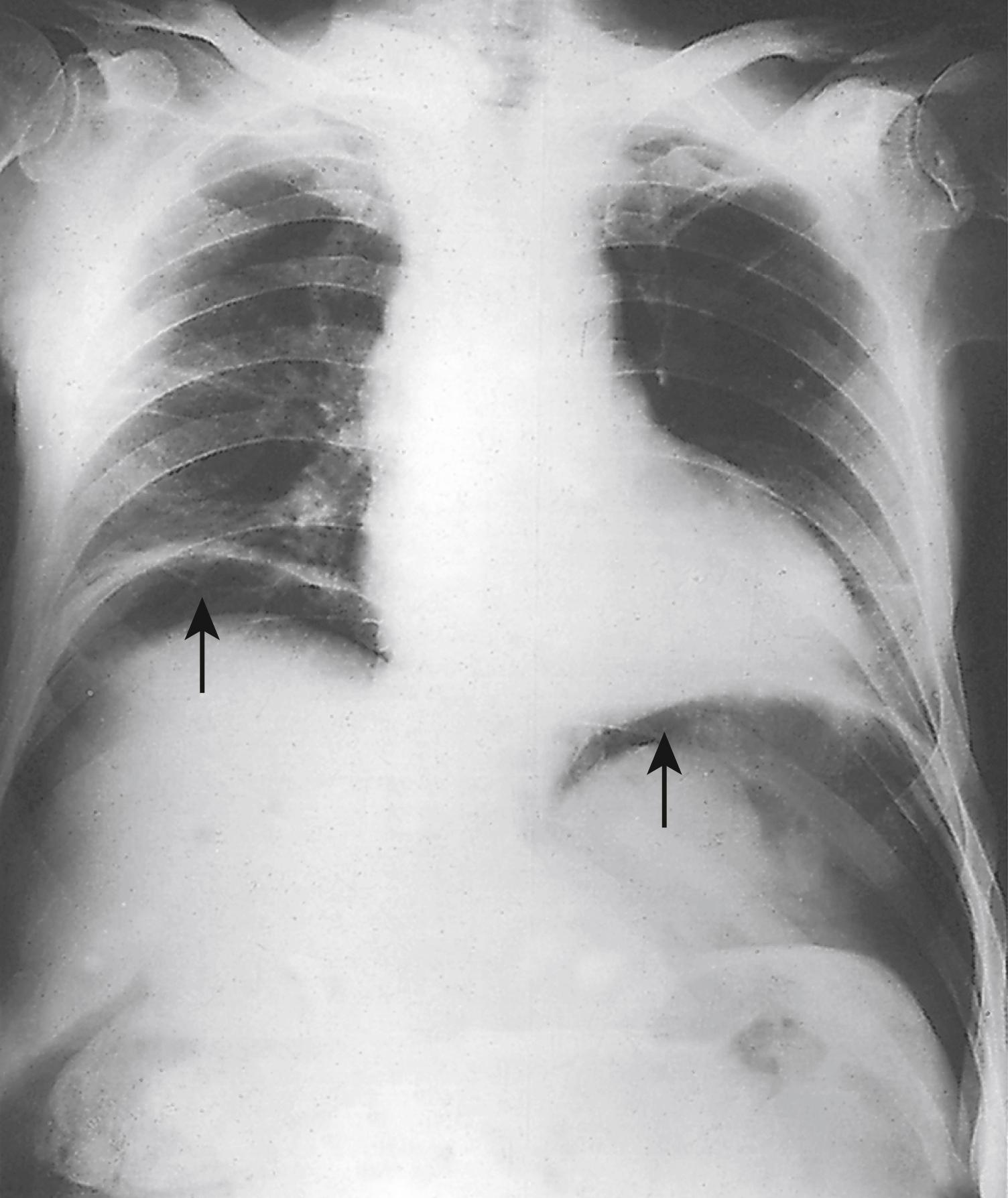
Computed tomography (CT): CT is a very accurate means of cross-sectional imaging that is increasingly used for the assessment of both elective and emergency surgical patients. The most accurate images are achieved when intravenous contrast is administered for the scan. Care should be taken in patients with dehydration or existing renal failure as intravenous contrast can predispose kidney function deterioration. In elective assessment, CT may be helpful when planning surgery for benign conditions such as large hiatus hernias. Staging CT of the chest, abdomen and pelvis for the investigation of upper GI cancer is often carried out after the patient drinks a significant volume of water to distend the oesophagus and stomach. In the emergency setting, CT of the chest and abdomen may be useful to assess the morphology and possibility of ischaemia in patients suspected of having volvulus of a large hiatus hernia, or in patients with suspected upper GI perforation, especially if a preceding CXR was negative ( Fig. 14.6 ). The identification of the exact site of perforation can be enhanced by the administration of oral contrast just prior to the scan.
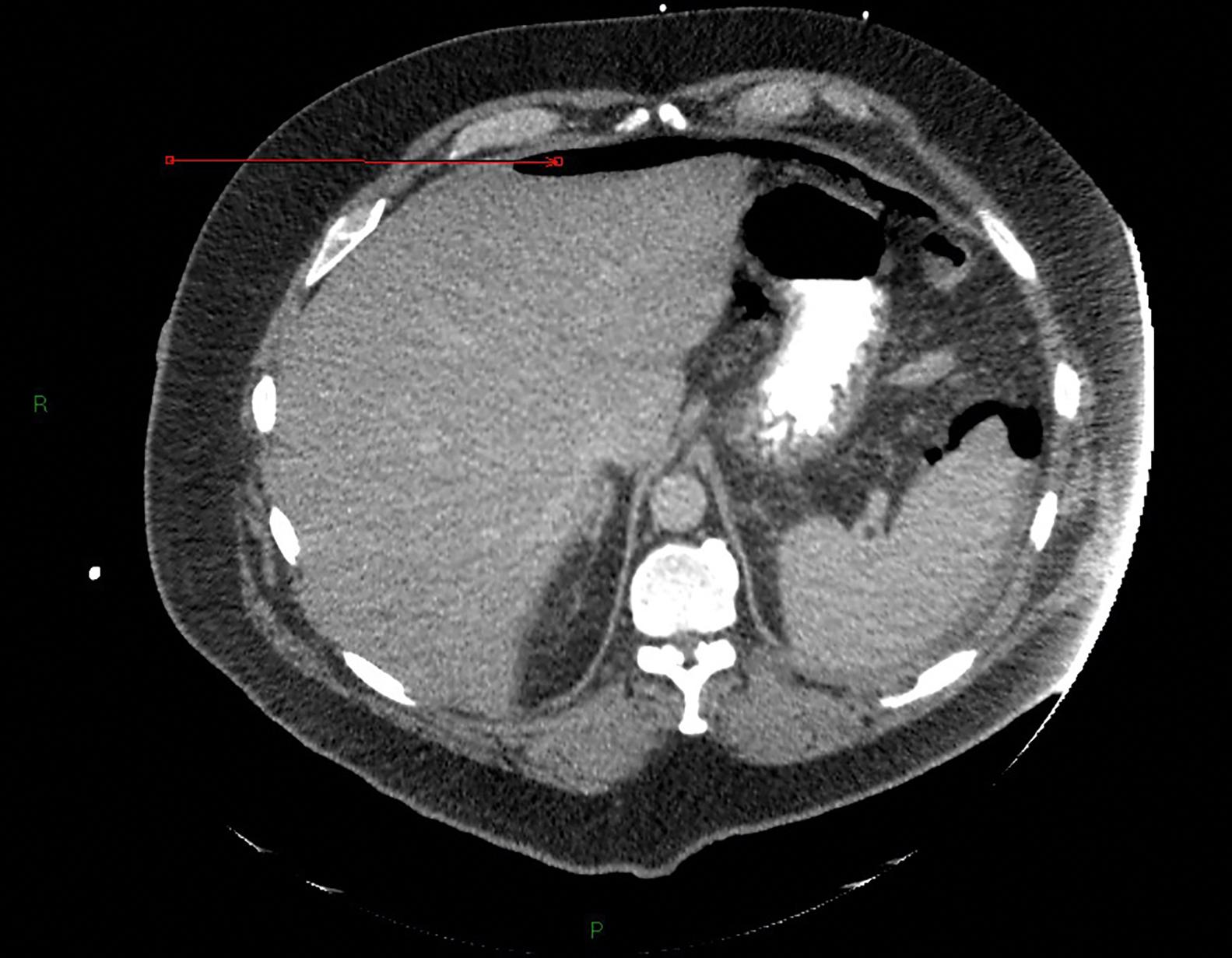
Contrast swallow/meal: CT allows for the static interpretation of images. However, if a more dynamic assessment of upper GI tract function is required, then a contrast swallow (to assess oesophagus) and/or meal (to assess stomach and duodenum) using barium liquid or water-soluble contrast may be useful ( Fig. 14.7A and B ). As the patient swallows the contrast in the upright position, multiple images are taken over time. Examples of when such a test may be useful include: as a primary investigation when access to upper GI endoscopy is limited (e.g., during the recent coronavirus crisis); to exclude a pharyngeal pouch prior to endoscopy; to diagnose suspected upper GI perforation in an emergency patient or as a routine check following a planned endoscopic therapeutic intervention; or to provide additional anatomic and functional information in complex patients with benign upper GI pathologies (e.g., achalasia, large hiatus hernia).
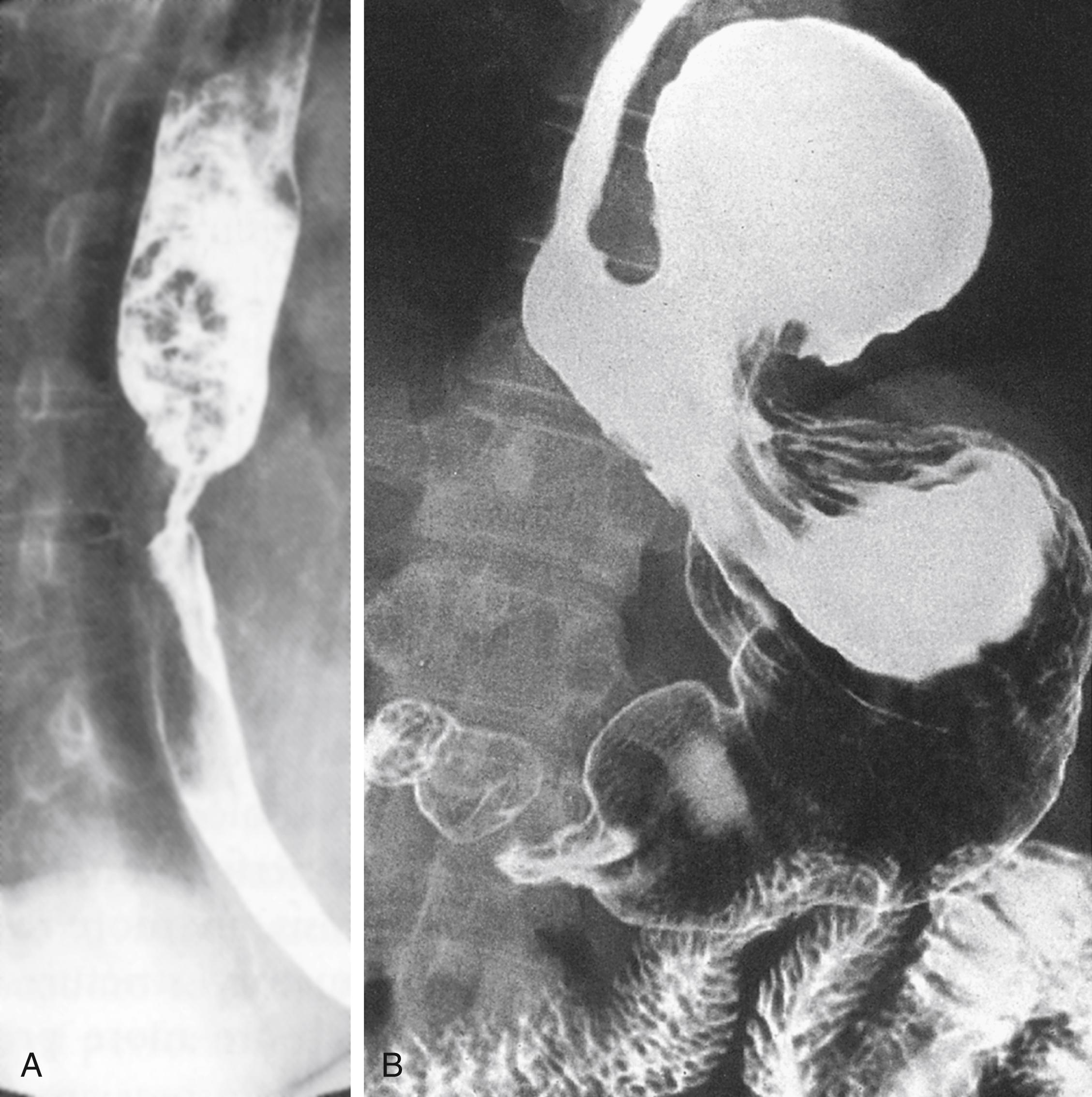
Gastric emptying studies: Gastric emptying scintigraphy is a nuclear medicine scan performed in patients with reflux, vomiting and early satiety in whom no structural cause has been seen for gastric outlet obstruction on OGD. The usual cause for impaired gastric emptying is autonomic neuropathy in diabetic patients, a condition known as gastroparesis. In a dual-phase test, the liquid and solid emptying phases of the stomach are assessed following ingestion of small amounts of a radionuclide, usually concealed within a standard meal of eggs, toast and water. A gamma camera is then used intermittently over the next few hours to monitor the progress of the radionuclide through and out of the stomach.
Positron emission tomography (PET): PET is a nuclear medicine scan used as a routine staging modality for patients with oesophageal cancer. It is based on the principle that tumour tissue is more metabolically active than normal tissue and thus more readily takes up metabolic radiotracers. The most commonly used radiotracer is F-18 fluorodeoxyglucose (FDG), an analogue of glucose. The patient needs to be fasted with normal blood glucose levels (which can be a problem in diabetics) prior to administration of the intravenous tracer. Nowadays, PET images are usually superimposed on another imaging modality (e.g., CT) to achieve superior detection of distant metastases that cannot be seen by CT alone. However, some tumours are not PET-avid (do not take up the radiotracer), and hence usefulness is limited in these patients. The value of PET scans in gastric cancer staging remains under evaluation.
Oesophagogastroduodenoscopy (OGD): The key diagnostic investigation in patients with upper GI symptoms is fibreoptic OGD. This can be performed via both the oral and transnasal routes using a flexible endoscope. The patients must be fasted prior to the examination. The procedure is usually performed under intravenous conscious sedation or after administration of an oropharyngeal local anaesthetic spray. The patient is usually placed in the left lateral position, and oxygen is administered via nasal prongs. Basic monitoring of vital signs (pulse oximeter, heart rate and blood pressure monitoring) is performed. General anaesthesia (GA) may be required for complex cases. Therapeutic interventions that can be accomplished via OGD include control of bleeding, dilatation of strictures, stent insertion to overcome obstruction, radiofrequency ablation of Barrett oesophagus (BO), endoscopic mucosal resection/endoscopic submucosal dissection of early tumours and debulking of advanced tumours using laser and argon plasma. OGD is a safe procedure but can be associated with complications such as bleeding and perforation, especially when therapeutic interventions have been performed. Rigid oesophagoscopy is available as an alternative to flexible endoscopy, but it requires GA and is usually reserved for ENT assessment of the oropharynx and upper oesophagus, and removal of large foreign bodies.
Endoluminal ultrasound (EUS): EUS combines the technology of flexible endoscopy with an ultrasound probe to allow imaging of the thickness of the wall of the upper GI tract and delineation of adjacent structures outside the lumen ( Fig. 14.8A and B ). In particular, it can be used in the TNM staging of oesophageal cancer to clarify the ‘T’ stage (how deep the tumour extends through the oesophageal wall) and the ‘N’ stage (the number of involved lymph nodes). Furthermore, needle biopsy can be employed through the EUS scope to confirm if local nodes are metastatic (especially when the result will influence planned treatment strategy) and to diagnose the nature of submucosal upper GI tumours that cannot be biopsied through standard endoscopic procedures (e.g., GI stromal tumours – GISTs) ( Fig. 14.9A and B ).
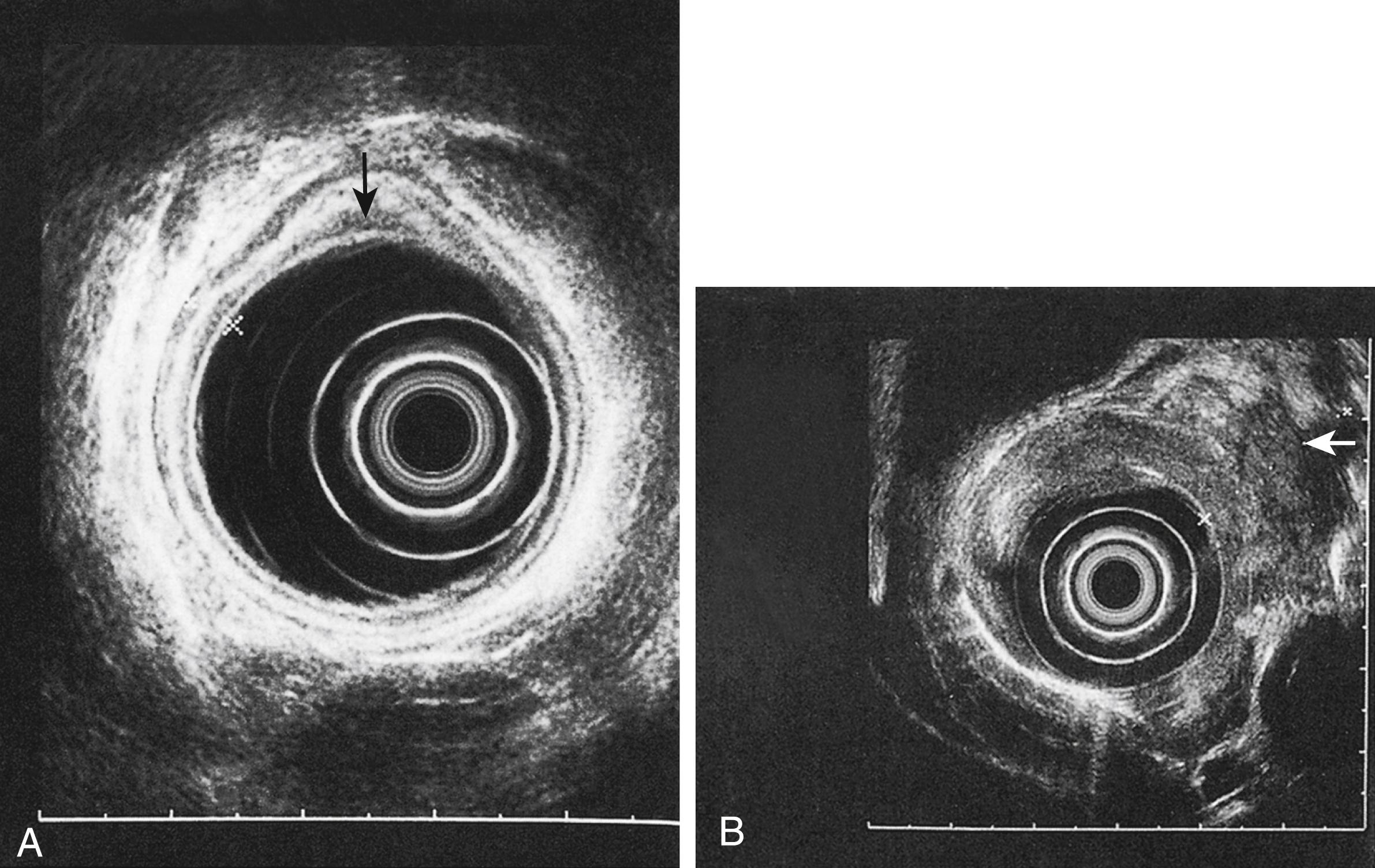
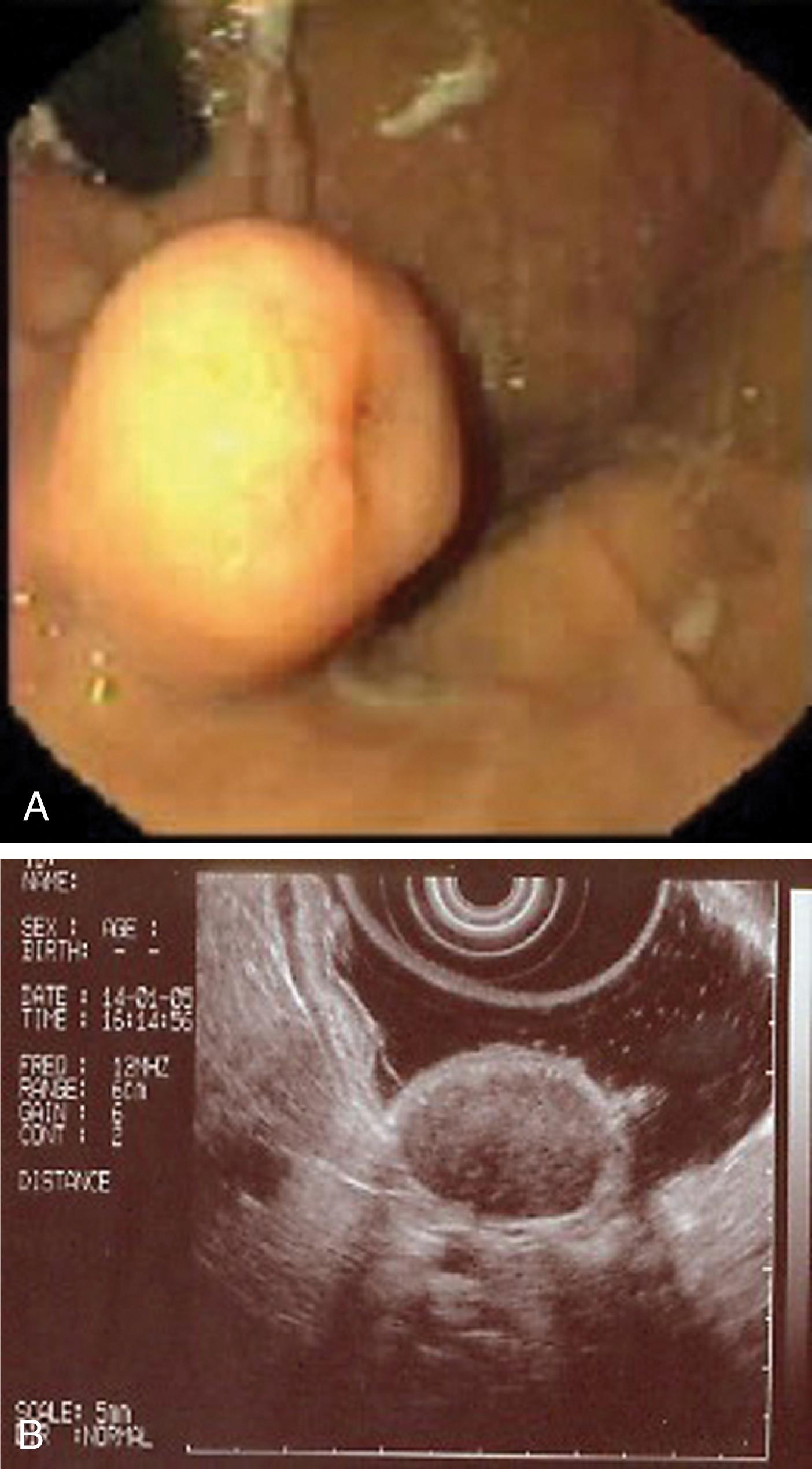
Oesophageal manometry is crucial in the diagnosis of oesophageal motility disorders (e.g., achalasia). In standard manometry, oesophageal pressure and peristalsis can be analysed during a series of swallows (station manometry) or over a longer period (ambulatory manometry) using a catheter inserted via the transnasal or transoral routes ( Fig. 14.10 ). Recently the development of high-resolution manometry (HRM) with multiple pressure sensors has revolutionised the interpretation and diagnosis of motility disorders using ‘ the Chicago classification ’. This classification system can accurately subtype motility disorders (e.g., it can subtype achalasia into types 1–3), which can offer additional prognostic information.
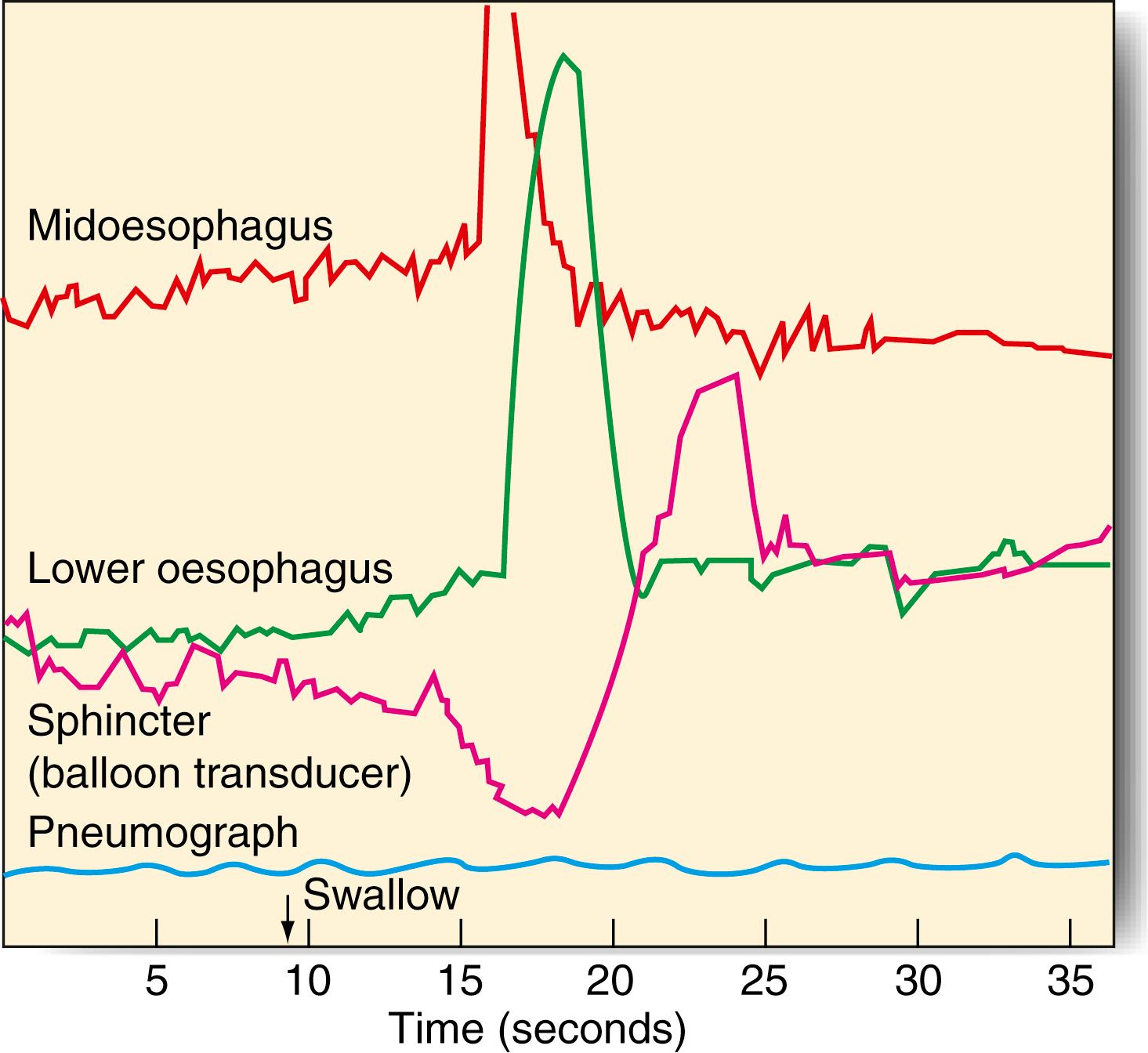
Measurements of lower oesophageal pH can be made over a 24-hour period using an intraluminal electrode placed 5 cm proximal to the upper end of the LOS attached to a catheter passed through the nose and pharynx. Alternatively, oesophageal pH can be measured over a minimum of 48 hours using a wireless (Bravo) capsule, which is attached to the oesophageal mucosa via suction and a clip ( Fig. 14.11 ). Pathologically high levels of acid exposure are demonstrated by measuring periods of time during which the oesophageal pH was <4. Patients can also indicate symptom events during the recording, and these can be correlated with the pH trace. Composite scoring systems (the DeMeester score) are available to help diagnose GORD. Patients being considered for antireflux surgery should first undergo oesophageal pH monitoring. If oesophageal pH studies are normal but patients still exhibit GORD symptoms poorly controlled by PPI, then oesophageal impedance should be performed. This newer technique is based on the measurement of changes in resistance to an alternating electrical current when a bolus passes by the catheter, and thus it can assess both acid and nonacid (e.g., bile) reflux.
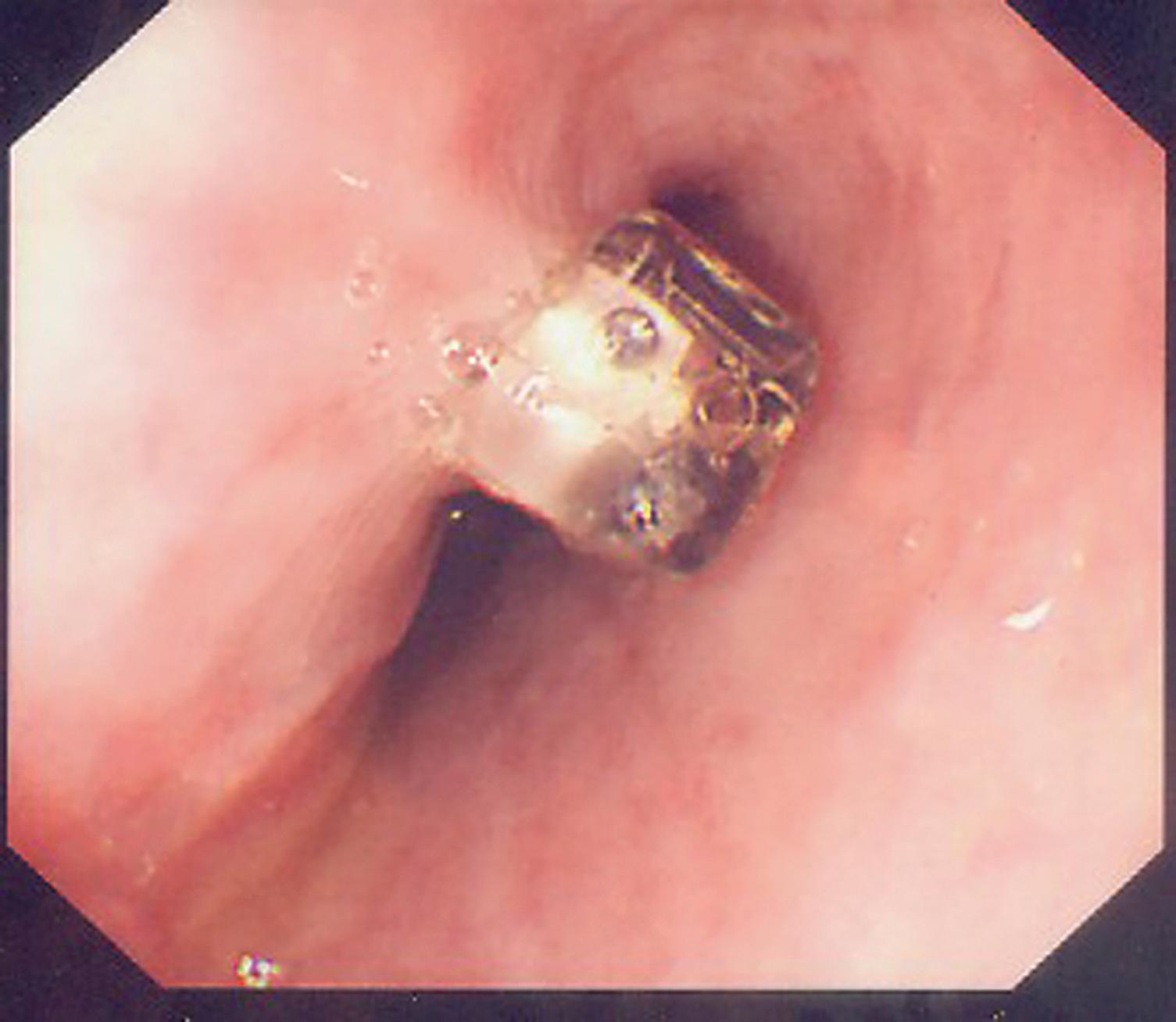
Staging laparoscopy is a minor operation performed under GA for the assessment of upper GI cancer. Because it focuses on the peritoneal cavity, it is preferentially used in patients with gastric or GOJ tumours with a large gastric component compared with oesophageal cancer. Gastric cancer has a propensity for transcoelomic spread (dissemination of malignancy across the peritoneal cavity), and staging laparoscopy is better at visualising small peritoneal and hepatic metastases compared with CT. Laparoscopy also allows visualisation of the ovaries in female patients to exclude Krukenberg tumours (ovarian metastases). Laparoscopy is usually combined with peritoneal washings (fluid sent for cytologic analysis) to exclude microscopic peritoneal spread that might prevent the possibility of curative surgery. When laparoscopy is used appropriately, it may influence the treatment strategy of approximately 20% of gastric cancer patients.
GORD is the most common digestive complaint worldwide and may affect up to one-third of the population. Patients typically complain of heartburn, regurgitation of acid into the back of their throat, nausea, waterbrash (hypersalivation), epigastric pain and occasionally vomiting. Atypical symptoms include sore throat, hoarse voice, cough and shortness of breath. The LOS usually prevents reflux by maintaining a resting pressure of 15 to 20 mm Hg.
A diagnosis of GORD is based on history, endoscopy findings and, in patients being considered for surgery, a 24-hour oesophageal pH/impedance study combined with manometry. In young patients and those without alarm symptoms, empirical treatment may be appropriate without any endoscopic investigations. However, it is recommended that such individuals undergo H. pylori testing. Severe long-term GORD can lead to the development of oesophagitis, benign (peptic) oesophageal strictures and BO.
Patients should be counselled about lifestyle changes, including weight loss if obese, smoking cessation and reducing alcohol intake. Patients should also be advised about those foods that can provoke symptoms through direct irritation (e.g., spicy foods) and further reductions in LOS tone (e.g., fatty foods, caffeine, chocolate). Many patients will already have tried over-the-counter remedies such as antacids, alginates or low-dose H 2 antagonists (e.g., ranitidine). Definitive treatment, however, is provided by a course of PPIs, the most potent inhibitors of acid secretion available. PPIs function by blocking the H+/K + ATPase of the gastric parietal cells. They are well-tolerated and some of the most commonly prescribed drugs in the world. Various conditions have been associated with long-term use (e.g., osteoporosis), but many of these studies have not demonstrated causal relationships. Other medications available for GORD include prokinetic agents, such as metoclopramide, which help patients by improving the lower oesophageal muscle tone, promoting gastric emptying and reducing nausea. However, such drugs may only be prescribed for short courses because of unwanted lasting side effects.
BO, otherwise known as columnar-lined oesophagus, is a premalignant condition in which there is a metaplastic change of the mucosal cells of the lower oesophagus from normal stratified squamous epithelium to simple columnar epithelium associated with goblet cells ( Fig. 14.12 ). BO may progress from metaplasia to dysplasia (low and high grade), ultimately leading to oesophageal adenocarcinoma. The histologic diagnosis of BO is confirmed after endoscopic biopsies. Not everyone with BO will develop cancer; the estimated rate of cancer incidence in BO is approximately 6 per 1000 patient-years. However, BO continues to increase in incidence, likely due to changes in Western lifestyle, and so patients with this condition represent a target group for endoscopic surveillance to detect early neoplasia ( EBM 14.4 ).
‘ It is vitally important for accurate diagnosis that the precise sites of biopsies taken are recorded by the endoscopist in terms of distance from the incisor teeth and relation to the oesophagogastric junction (Recommendation grade C). ’
If detected, high-grade dysplasia can be eradicated successfully by endoscopic radiofrequency ablation (RFA), whereas early tumours may be removed via endoscopic mucosal resection (EMR) or endoscopic submucosal dissection (ESD).
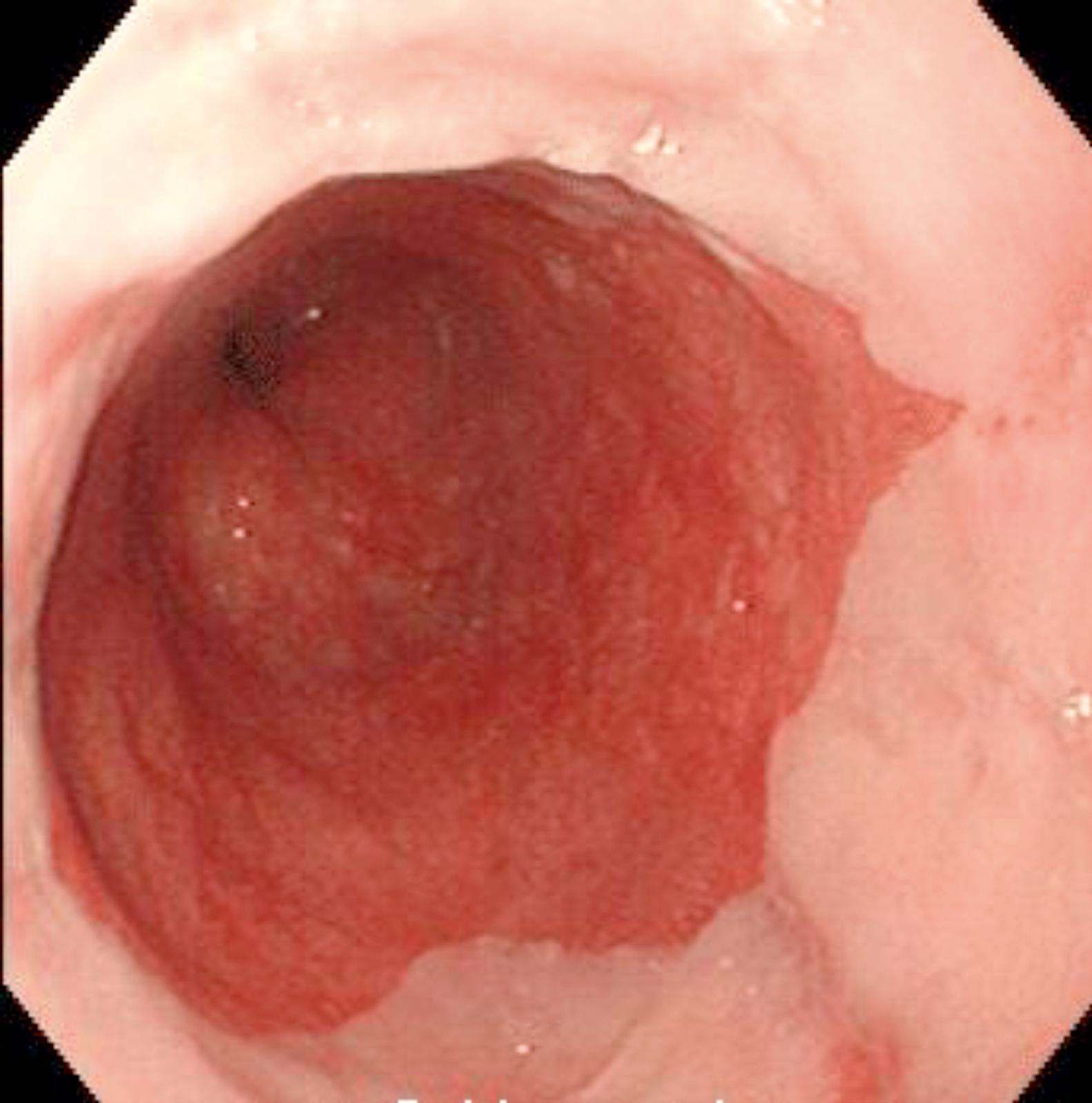
Surgery for GORD may be indicated for patients whose symptoms cannot be controlled by medical therapy, those with complicated reflux disease (stricture formation, respiratory complications, other atypical symptoms) and those who either do not wish to continue taking long-term acid suppression therapy or who are intolerant of such treatments. Symptoms that fail to be brought under control with acid suppression therapy are often due to high-volume alkaline reflux, and surgery is an extremely effective cure ( EBM 14.5 ).
‘ It has been shown that, following antireflux surgery, quality of life is improved and costs are reduced significantly compared with medical treatment. Antireflux surgery should be offered to patients with proven symptomatic reflux that cannot be controlled symptomatically with medical therapy. ’
The presence of Barrett metaplasia alone is not considered a suitable indication for antireflux surgery.
Surgery is usually performed in a minimally invasive fashion (either laparoscopically or robotically) and involves manoeuvres aimed at restoring the high-pressure zone at the lower oesophagus. Such manoeuvres consist of reduction of any hiatus hernia if present, mobilisation of the intraabdominal oesophagus, approximation of the diaphragmatic crura around the lower oesophagus and fundoplication. This latter procedure involves mobilising the fundus of the stomach from its attachments to the undersurface of the left hemidiaphragm and the left crus, and wrapping it around the oesophagus, either anteriorly or posteriorly. The most common procedure is the Nissen fundoplication in which the fundus is taken posteriorly around the lower oesophagus and sutured to the left anterior surface of the left side of the proximal stomach as a 360-degree wrap ( Fig. 14.13A, B and C ). This manoeuvre usually requires division of the short gastric vessels. Other procedures involving a partial (incomplete) fundoplication include Toupet (posterior 270-degree wrap) and Watson (anterior 180-degree wrap) repairs. Current data do not demonstrate much difference in overall patient satisfaction between the various approaches; Nissen fundoplication is associated with more postoperative dysphagia, but partial fundoplications have less durable reflux control. Satisfaction rates at 10 years are approximately 85%. Unwanted complications after surgery include gas bloat (uncomfortable distension of the stomach due to an inability to belch), dysphagia, early satiety and increased flatus.
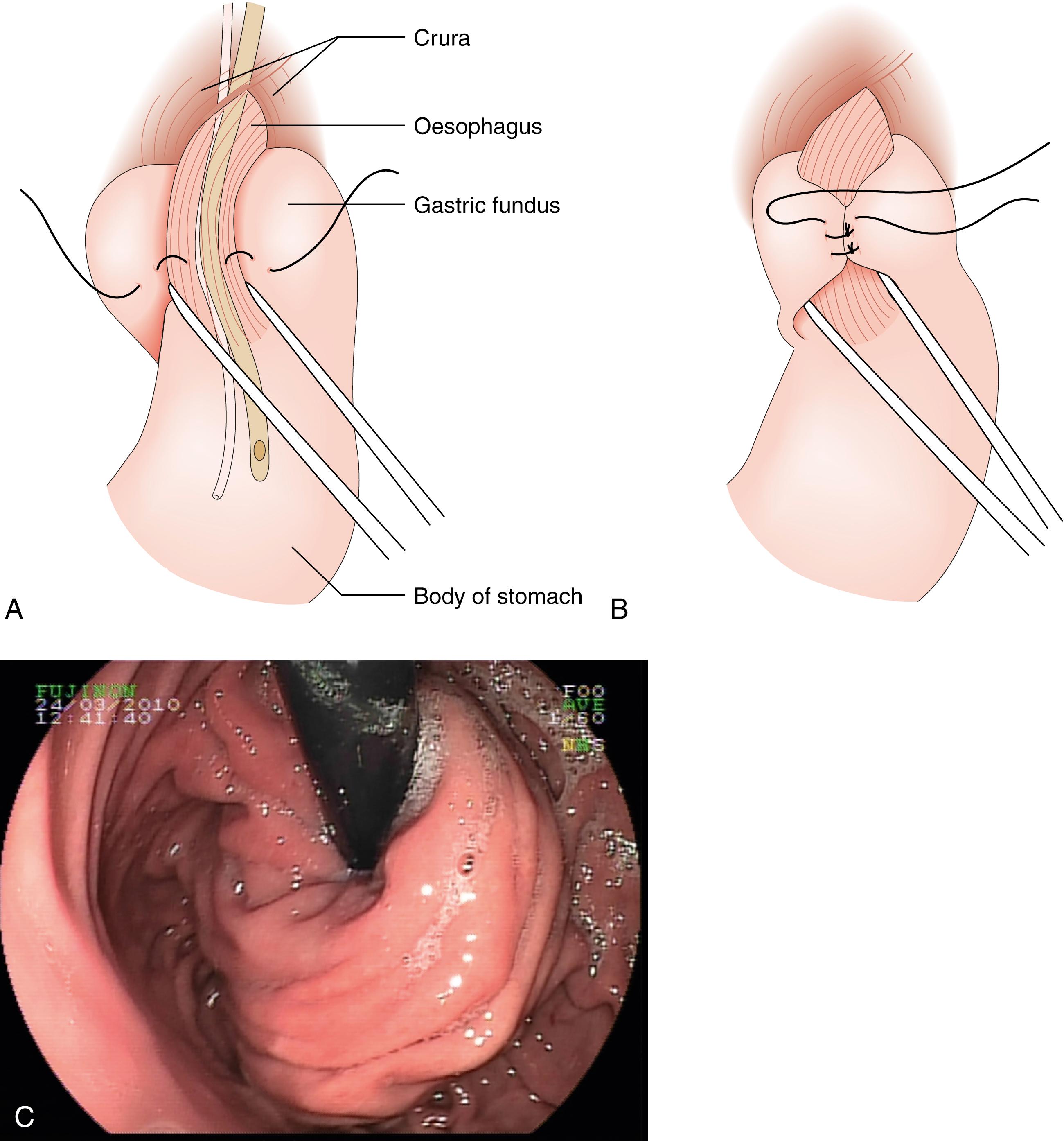
Alternatives to surgical fundoplication are now available. The Stretta® procedure uses the endoscopic application of radiofrequency energy to the LOS to induce tissue thickening and control reflux. In comparison, the LINX® device is a bracelet of magnetic titanium beads placed laparoscopically around the GOJ. When food passes through the GOJ, the bracelet stretches to accommodate then contracts through magnetic attraction to prevent reflux. Both types of procedure are less invasive than fundoplication and are reported as having good results in selected patients. However, long-term results comparable to fundoplication are not yet available.
Reflux-type symptoms are very common
‘Lifestyle’ advice to patients is important (i.e., smoking, weight loss, etc.)
PPIs are generally effective treatment
GORD for >10 years is a risk factor for Barrett oesophagus (especially in men)
Screening and surveillance for Barrett patients is increasingly relevant
Laparoscopic antireflux surgery is clinically effective and cost-efficient
A hiatus hernia is an abnormal protrusion of the stomach through the oesophageal diaphragmatic hiatus into the thorax and may be sliding, rolling or mixed ( Fig. 14.14A, B and C ). Sliding hernias are by the far most common with rolling or mixed hernias accounting for only 10% to 15%. A sliding hernia occurs when the upper stomach slides through the diaphragmatic hiatus so the GOJ lies within the thoracic cavity. The hernia is covered anteriorly by a peritoneum sac, whereas posteriorly it is extraperitoneal. A rolling or paraoesophageal hernia is formed when part of the stomach (usually the fundus) rolls up through the hiatus alongside the oesophagus; the cardia and GOJ remain in their normal positions. Mixed hiatus hernias involve elements of both types, and when most of the stomach is situated in the chest, such hernias are referred to as intrathoracic stomachs. Hiatus hernias are caused by weakness of the diaphragmatic hiatal muscles and are more commonly found in women, obese patients and patients >50 years of age.
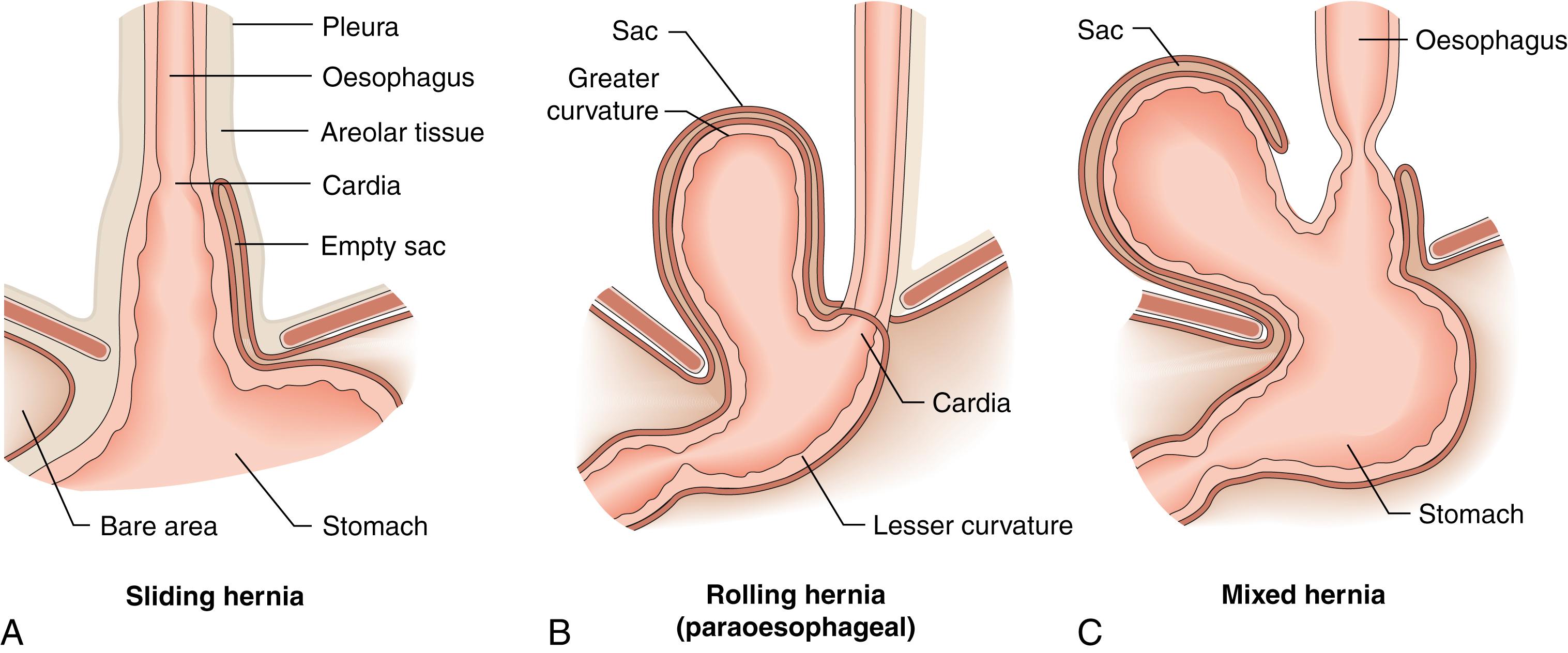
Hiatus hernias are often asymptomatic and are sometimes only found incidentally during endoscopic and radiographic investigations. However, they can also produce some or all the following symptoms:
Heartburn and regurgitation – owing to an incompetent LOS, which is aggravated by bending and lying flat at night, and can be relieved by antacids.
Oesophagitis – resulting from persistent acid reflux, which can lead to ulceration, bleeding with anaemia, fibrosis and stricture formation.
Epigastric and lower chest pain – especially in paraoesophageal hernias, as the herniated part of the stomach (usually the fundus) can become trapped and twisted in the chest (volvulus) leading to obstructive symptoms. This can be a surgical emergency if complete outlet obstruction, or strangulation, of the stomach develops.
Gastric ulcers – irritation of the stomach at the level of the diaphragmatic hiatus can lead to the development of linear ulcers or erosions ( Cameron lesions ), which can result in chronic iron-deficiency anaemia and, less often, acute bleeding.
Palpitations and hiccups – symptoms caused by the mass effect of the hernia in the thoracic cavity irritating the pericardium and the diaphragm.
Shortness of breath – if the hernia is of sufficient size, it may occupy a significant portion of the thoracic cavity, leading to breathlessness.
Treatment for patients presenting electively is the same as for GORD. Patients with obstructive symptoms, such as vomiting, regurgitation or breathlessness due to reduced lung capacity, should also be considered for surgical repair. Even large hiatus hernias can be repaired laparoscopically, although the risk of conversion to open surgery is higher. Mesh augmentation of the diaphragmatic hiatus may be used to delay or reduce the risk of hernia recurrence. Rolling or large hiatus hernias cannot be treated by endoscopic means.
Patients who present as an emergency with a volvulus-obstructed hiatus hernia should have it decompressed with a nasogastric tube to prevent strangulation. This can sometimes be difficult due to the twisted nature of the stomach; in this situation, the patient may be exhibiting Borchardt’s triad – severe epigastric/chest pain, retching without vomiting and inability to pass an NG tube. In this eventuality, decompression by endoscopy may be required. Immediate emergency surgery is rarely required unless gastric necrosis is suspected. However, many patients will require expedited elective surgery as, once obstructive symptoms develop, they tend to recur.
Achalasia is a motility disorder of the oesophagus. The main features are failure of relaxation of the LOS, increased LOS tone and absent or uncoordinated peristalsis, leading to a dilated oesophagus. Achalasia is thought to be due to a selective loss of inhibitory neurons of the myenteric plexus of Auerbach; in the later stages of the disease, loss of the dorsal vagal nuclei within the brainstem can be demonstrated. Infestation with the protozoon Trypanosoma cruzi, which occurs in South America (Chagas disease), also causes degeneration of the myenteric plexus, leading to a disorder that is very similar to achalasia. Malignancy of the GOJ can sometimes mimic achalasia and is referred to as pseudoachalasia .
The incidence of achalasia is 1 in 100,000 of the population of developed countries. The patient is typically 30 to 40 years old, and men and women are affected in equal numbers. There is progressive dysphagia over several years, often greater for liquids than solids (in contrast to dysphagia from carcinoma). Gravity rather than peristalsis is responsible for food leaving the oesophagus, and the patient finds it easier to eat when standing. There may also be retrosternal pain, which gradually decreases in severity as the oesophagus loses peristaltic activity. Other common symptoms include weight loss, halitosis and regurgitation of undigested food, which can lead to aspiration, particularly at night, resulting in bouts of coughing, pneumonia and recurrent chest infections. The diagnosis of achalasia is confirmed using the gold-standard test of high-resolution oesophageal manometry (HRM), which can resolve achalasia into one of three subtypes: Subtype 1, absent pressures; Subtype 2, uniform pressures and Subtype 3, spasm pressures. Barium swallow may show a smooth narrowing (bird beak appearance) with evidence of proximal oesophageal dilatation (megaoesophagus) ( Fig. 14.15A and B ). Endoscopy is performed to rule out the possibility of cancer as a cause for symptoms. However, in the longer term, achalasia can also predispose to squamous cell carcinoma of the oesophagus; so, after diagnosis, patients should be entered into endoscopic surveillance programmes.
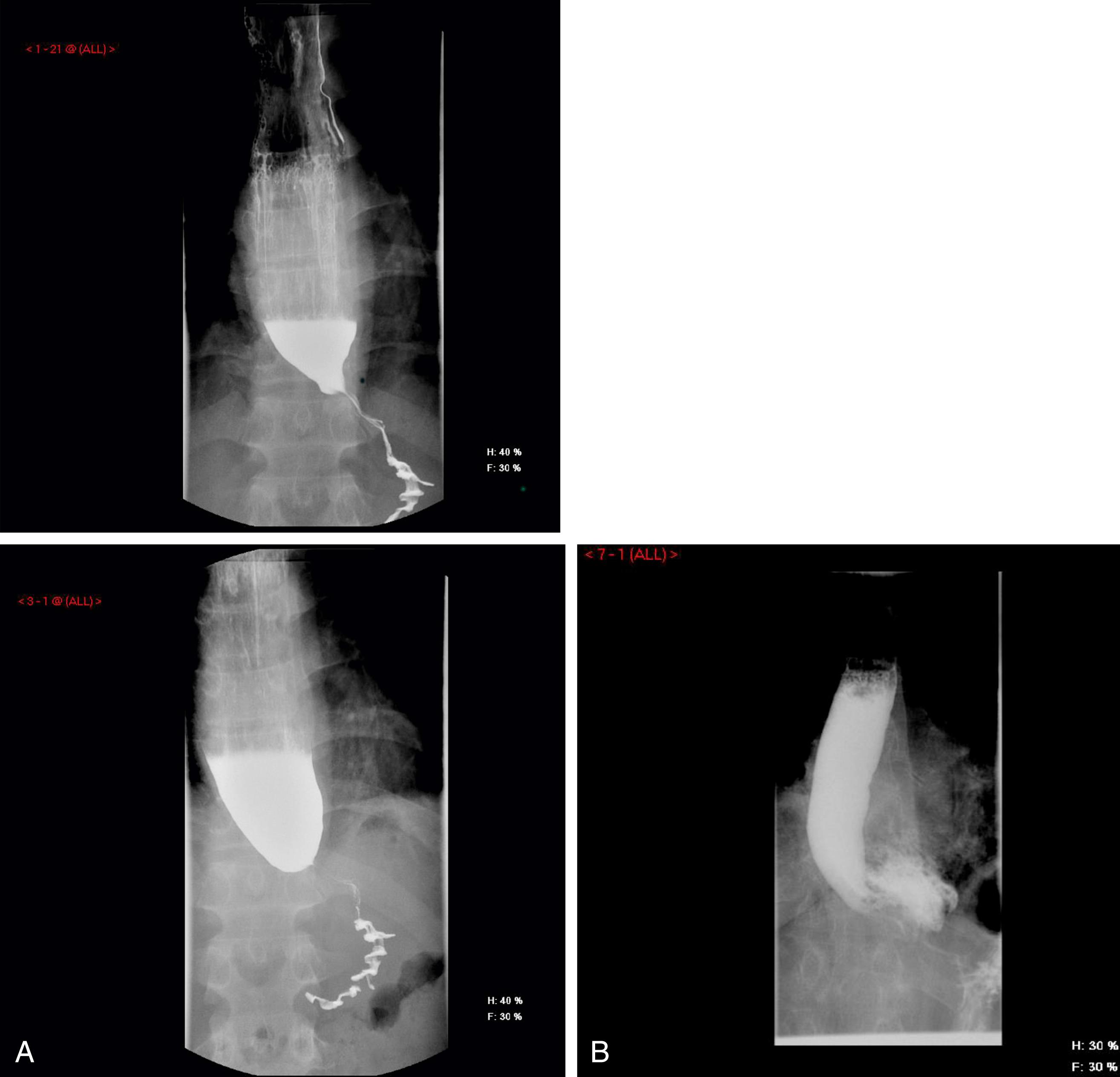
Medical treatment of achalasia involves agents that reduce LOS pressure, such as calcium channel blockers (e.g., nifedipine) and glyceryl trinitrate. However, the effect is usually transitory, and patients may experience unwanted side effects, e.g., headache. Endoscopic treatments include:
Botulinum injection – injection of the LOS gives symptomatic relief but may wear off after 6 months.
Pneumatic dilatation – uses a balloon to disrupt the muscles of the LOS and improve symptoms in 80–90% of patients. However, the procedure may require more than one administration and carries the risk of oesophageal perforation ( Fig. 14.6 ).
Per-oral endoscopic myotomy (POEM) – a form of natural orifice, transluminal, endoscopic surgery by which a submucosal tunnel is created, and the circular muscle of the GOJ is divided. Although still classified as an experimental procedure in some countries, it is increasingly popular; one randomised controlled trial concluded superior results compared with pneumatic dilatation. The main long-term complications of POEM are GORD and oesophagitis.
Operative treatment involves a Heller myotomy, whereby the outer longitudinal and inner circular muscle of the LOS are divided down to the mucosa 5 cm above the GOJ and 3 cm down the stomach. An anterior partial fundoplication is carried out at the same time to reduce the risk of postoperative GORD. Procedures are routinely performed in a minimally invasive fashion, either laparoscopically or robotically. Early complications include perforation, and late complications include reflux oesophagitis and recurrent dysphagia from an inadequate myotomy. Randomised controlled trials comparing myotomy and dilatation demonstrate no significant differences in patient outcomes (although the perforation rate is higher after pneumatic dilatation; EBM 14.6 ).
‘For the treatment of esophageal achalasia, laparoscopic Heller’s myotomy and pneumatic dilatation were found to be similar in terms of their long-term efficacy, as well as in terms of the posttreatment gastro-esophageal reflux rates. However, the perforation rate appears to be lower when laparoscopic Heller’s myotomy is employed.’
However, studies comparing POEM versus laparoscopic myotomy concluded that POEM was more effective at relieving dysphagia but was associated with high rates of pathologic GORD.
Otherwise known as diffuse oesophageal spasm, this motility disorder tends to occur in middle-aged to elderly patients. Complaints are of intermittent dysphagia and retrosternal pain, which can mimic angina pectoris. The syndrome is defined by premature oesophageal contractions with normal GOJ relaxation. HRM is required to confirm the diagnosis. Distal oesophageal spasm can be precipitated by GORD, and this should be excluded by 24-hour pH studies. Barium swallow may reveal a corkscrew oesophagus.
Treatment options are similar to those for achalasia. Surgery involves a long myotomy, but results are unpredictable, thus most patients are treated medically with calcium channel blockers, sublingual GTN and PPIs. POEM is currently being evaluated as a means of safely delivering long myotomies to patients with spastic oesophageal disorders.
Otherwise known as nutcracker oesophagus or hypertensive peristalsis, this uncommon motility disorder is characterised by repetitive forceful peristaltic contractions. HRM demonstrates normal peristalsis but with excessive amplitudes and pressures exceeding 180 mm Hg. Similar to distal oesophageal spasm, most patients are middle-aged to elderly, and as with all motility disorders, symptoms include dysphagia and severe chest pain. Medical treatment is similar to distal oesophageal spasm, but the results are disappointing. Dilatation and surgical myotomy also have poor results, but patients should be reassured that the condition is benign and nonprogressive.
This is an allergic, inflammatory condition associated with an infiltrate of eosinophils in the oesophageal mucosa. The cause of the condition is not clear but may include food allergy. Affected patients may have other allergic diseases such as asthma or eczema. It is increasing in prevalence (1:2000 people) and may affect adults and children alike, with a slight male preponderance. The typical patient presents with dysphagia, food bolus obstruction, vomiting and symptoms of GORD. Endoscopy may demonstrate a ‘ringed oesophagus’, and biopsies will confirm a high eosinophil count in the superficial epithelium. Treatment involves dietary therapy to remove allergenic triggers; PPIs and orally administered topical steroids; and endoscopic dilatation if significant strictures develop.
Pouches are protrusions of mucosa through a weak area in the oesophageal muscle wall. The most common pouch lies in the pharynx (pharyngeal pouch, otherwise known as Zenker diverticulum ) and is associated with raised cricopharyngeal pressure, with the pouch developing through Killian dehiscence, between the thyropharyngeus and cricopharyngeus muscles. Uncoordinated swallowing and failure of relaxation of the cricopharyngeus muscle cause the herniation. The pharyngeal pouch usually develops posteriorly and is forced by the vertebral column to deviate usually to the left side.
Pouches can also occur elsewhere in the oesophagus. A midoesophageal diverticulum is usually a traction diverticulum caused by mediastinal inflammation, whereas an epiphrenic diverticulum (just above the diaphragm) is often the result of an oesophageal motility disorder.
Elderly male patients are more commonly affected. The patient may be asymptomatic with the pouch detected through investigations for other reasons. However, when present, symptoms include dysphagia and, if food is trapped in the pouch, regurgitation, halitosis and aspiration with cough. Pharyngeal pouches may also be associated with the sensation of a lump in the throat or audible gurgling.
Barium swallow demonstrates the pouch and uncoordinated swallowing. Endoscopy also confirms the diagnosis but must be performed with care to avoid accidental perforation of the pouch.
Become a Clinical Tree membership for Full access and enjoy Unlimited articles
If you are a member. Log in here